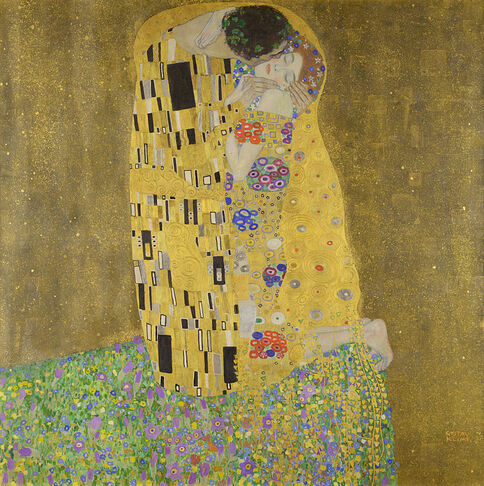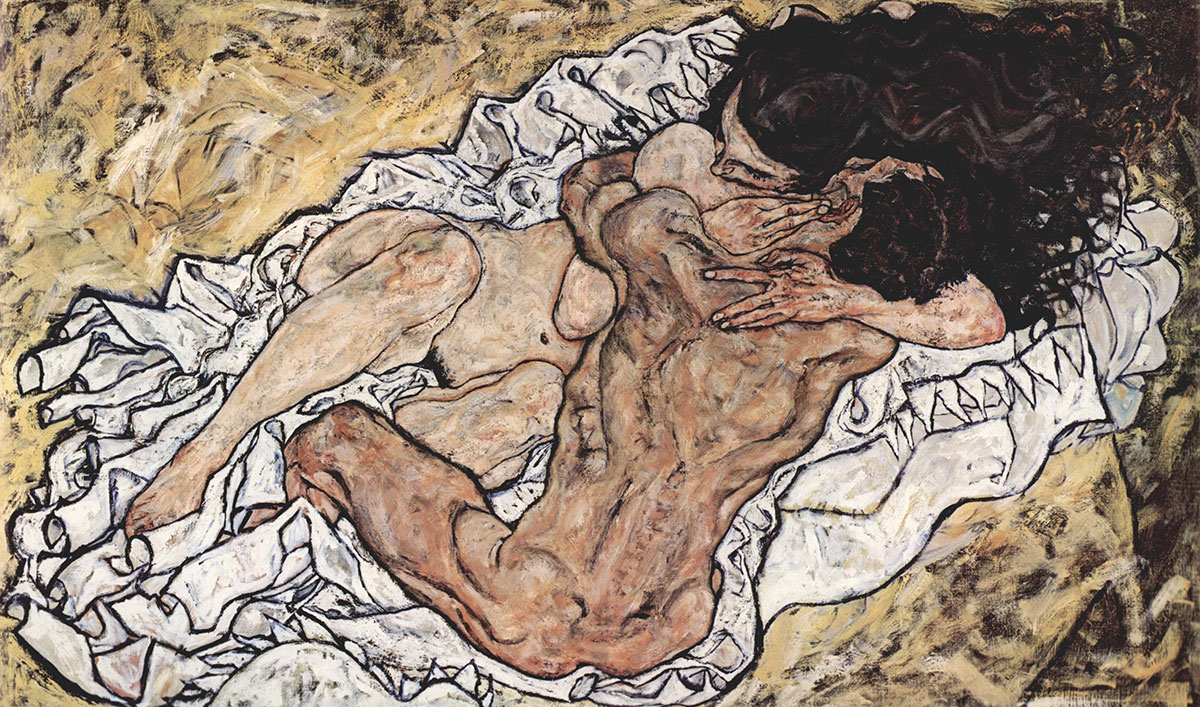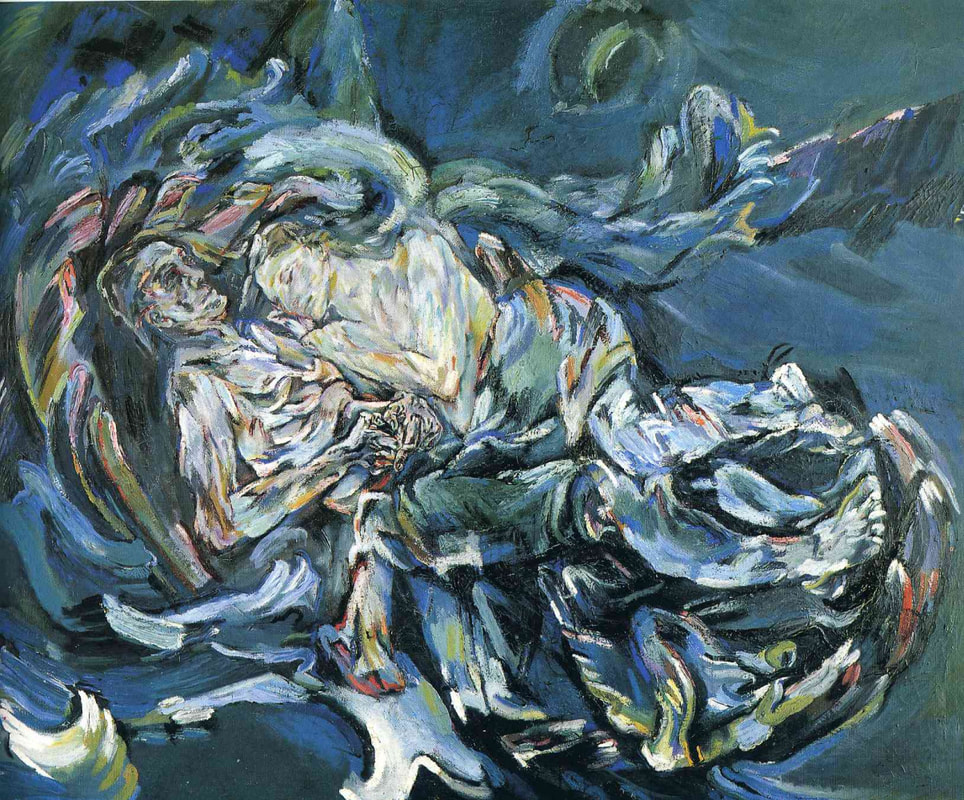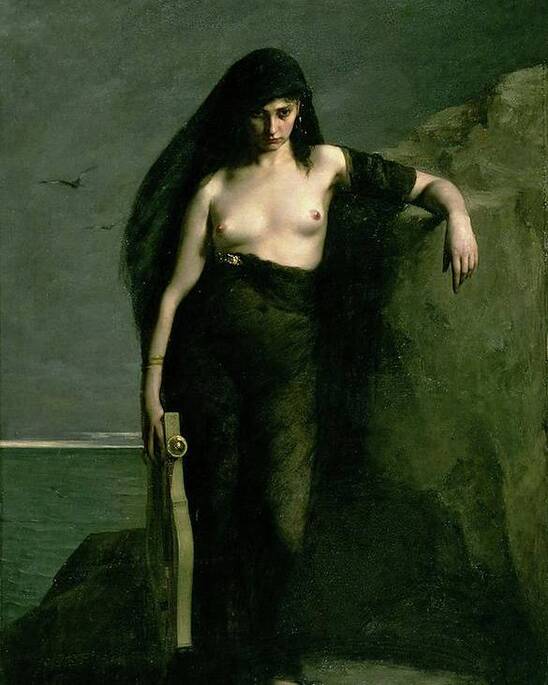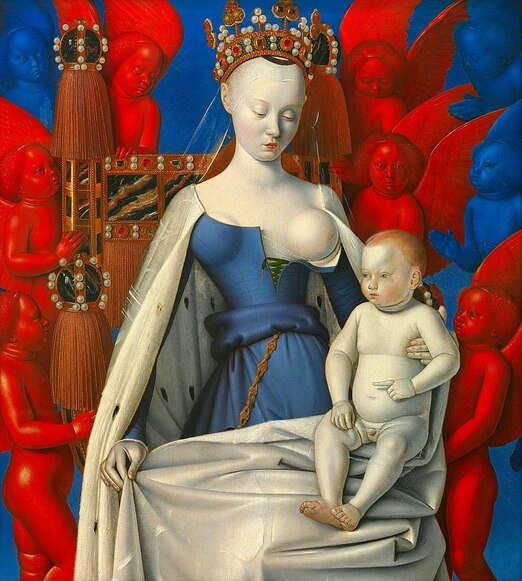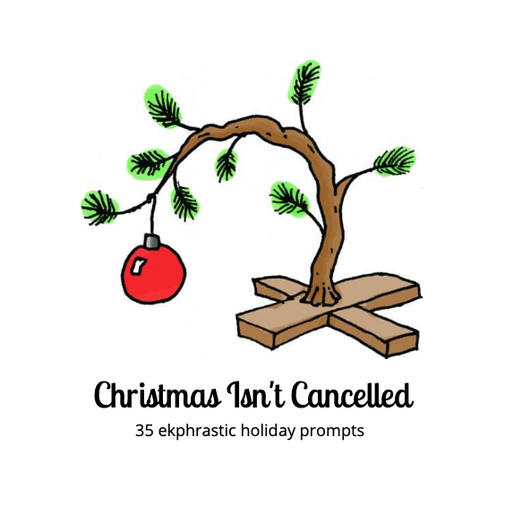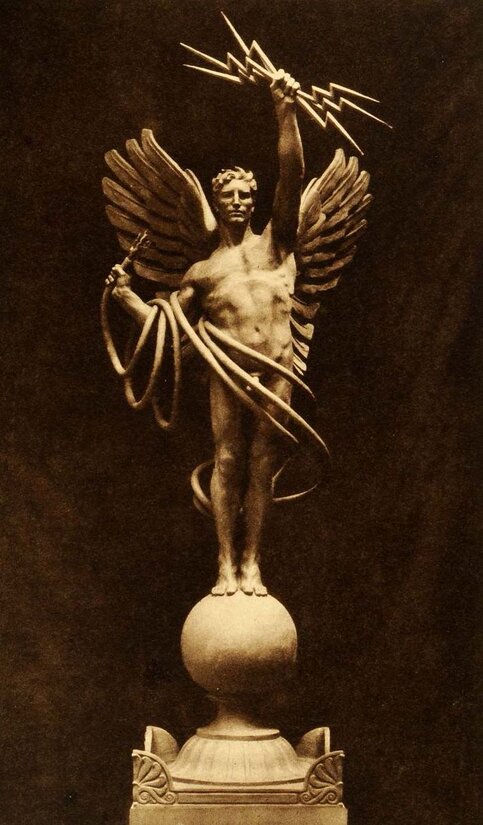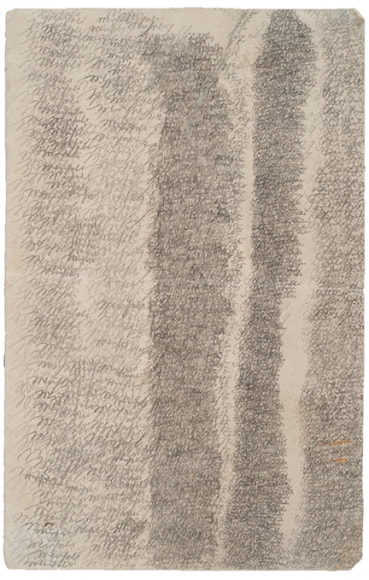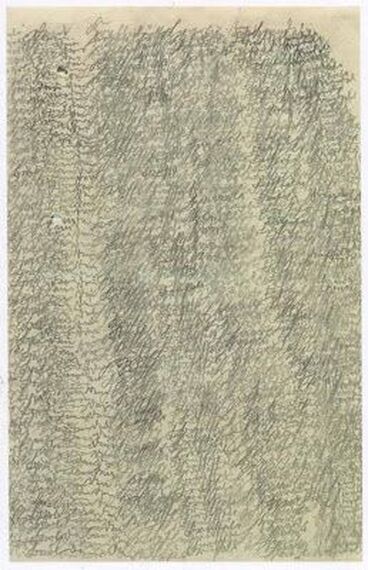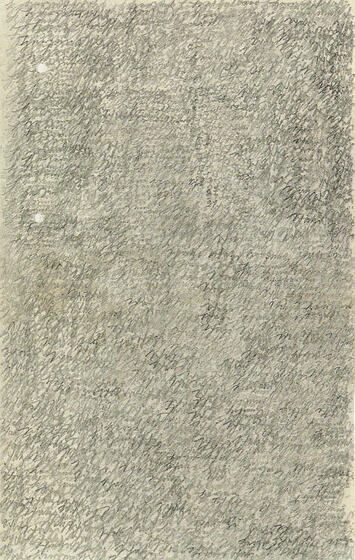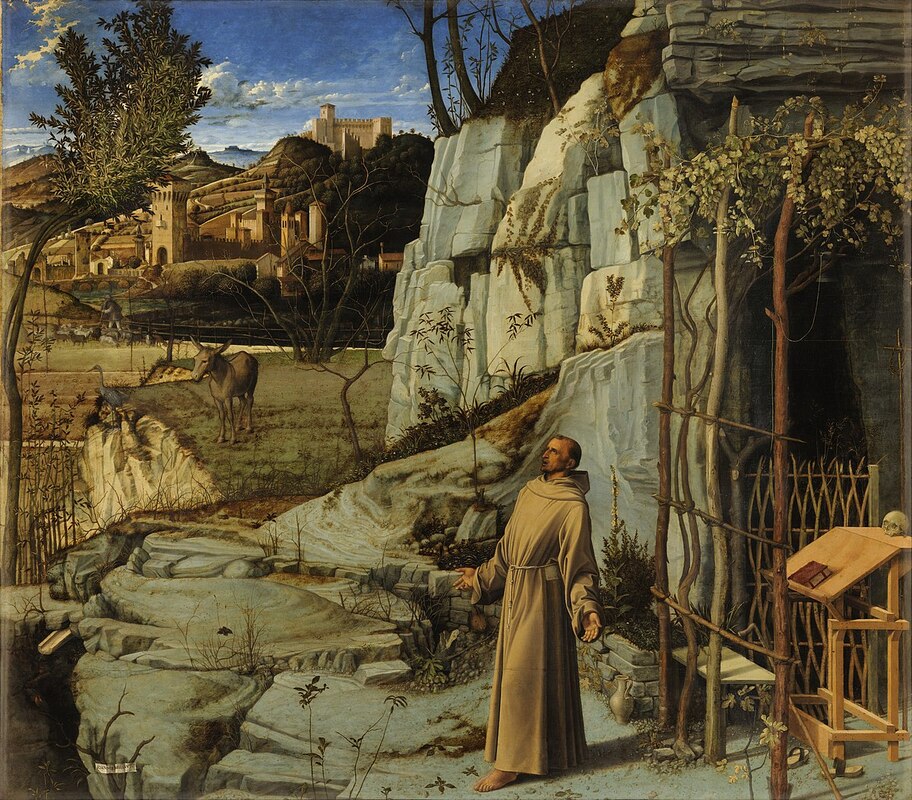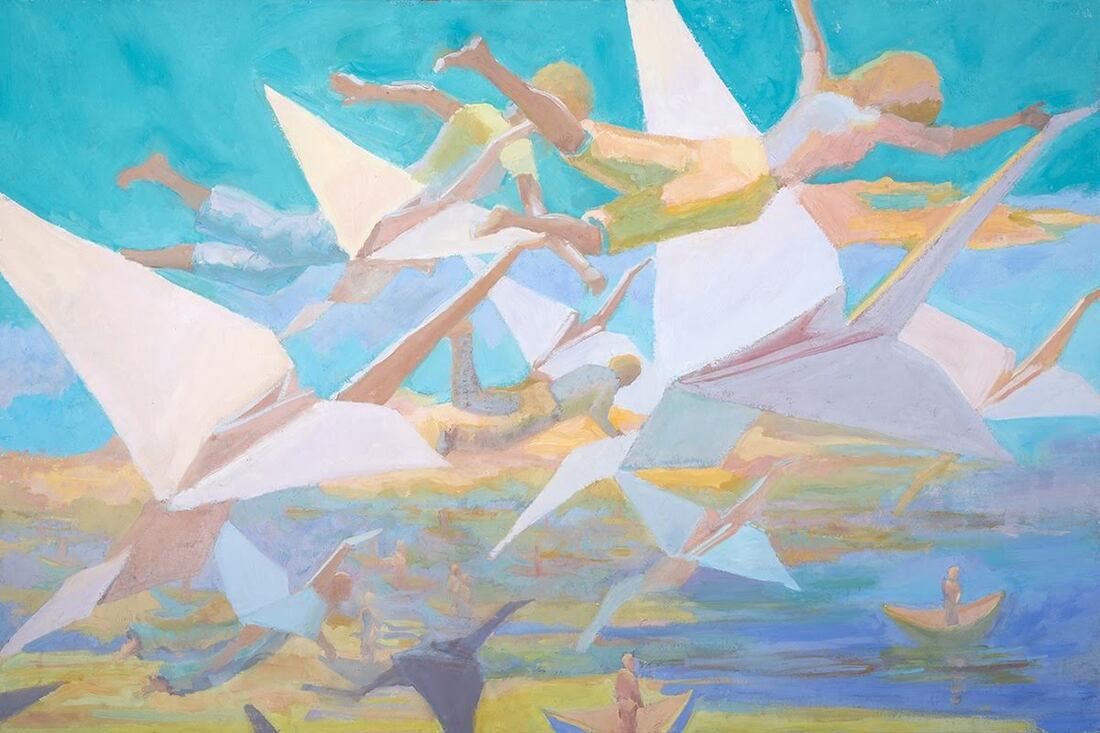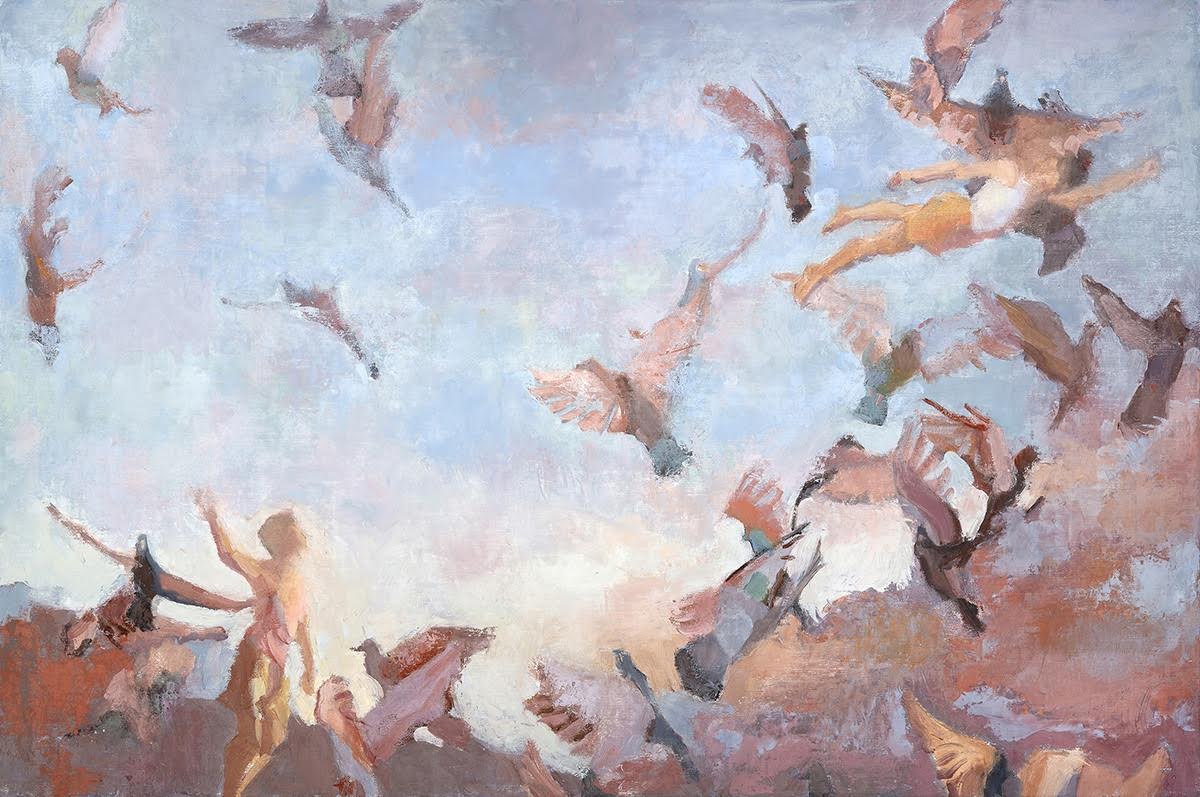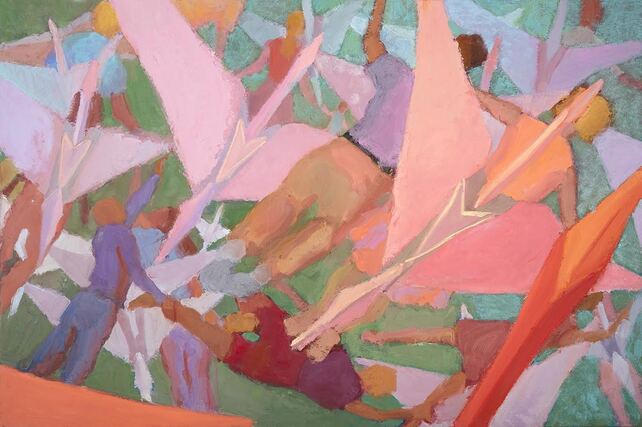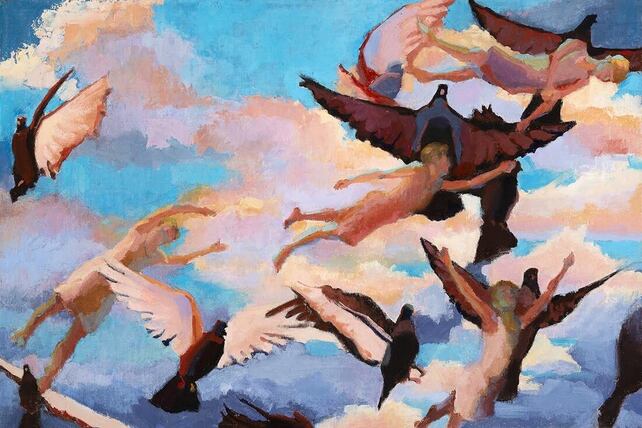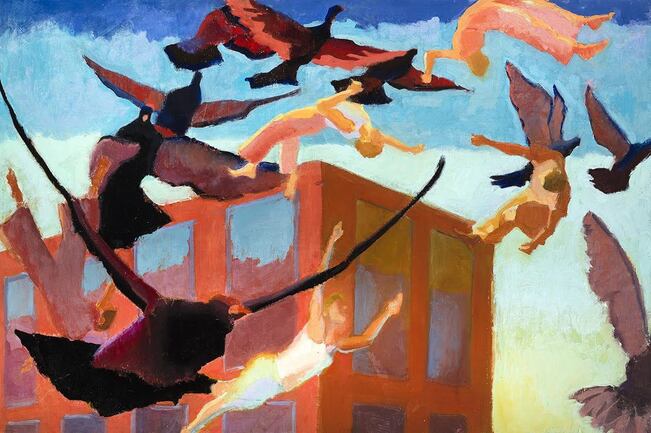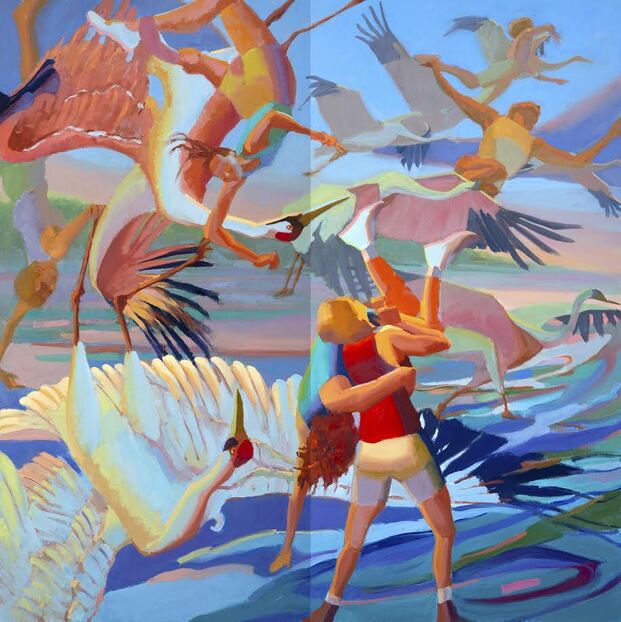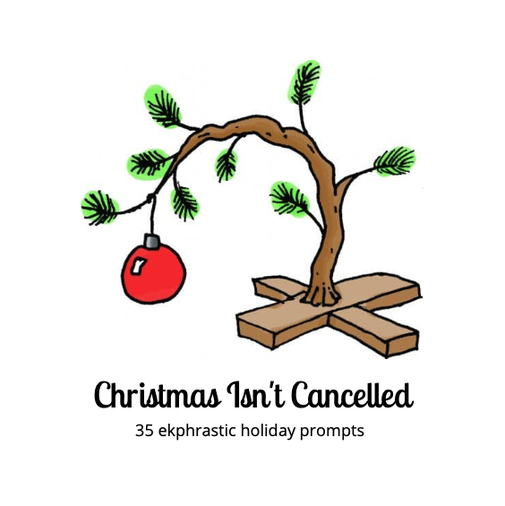|
A Triptych Visibile Parlare in Sotto Voce I. What the Painter Hears A Song from the Viennese, Whispered to Klimt You wanted our encounter to be a ritual, planned every detail: Ivy circled your hair, I interlaced mine with violets and jasmine. Wrapped in a diaphanous sarong, I stood by the bed of forget-me-nots. You held me against your silk kimono, the sun's folded wings framed us in its golden coin. Losing my balance, I fell on my knees, clinging to you, my arm around your bent shoulder. Eyes closed, I could see your hands cupped around my face as if holding a precious porcelain. I pressed my toes against the ground afraid we’d sink into the abyss, both trapped within one trunk, one womb, as if you were my own and I, Mother Earth bearing fruit, merging our beginnings. Let me become that space between your palms, the mark of your lips on my cheek. II. The Artist as Voyeur Schiele’s Glimpse at Love I want them to hold each other as if it were their last embrace. It is unusual, I know, for anyone to witness such fiery tenderness but long to see desire itself as I’ve always dreamt it, not as I saw it in eyes saddened by layers of Kohl and mascara. Isn’t it what the child in us seeks, to be one with the primal act of one’s conception? I want to forget the circled eyes of children consumed by their own fire, their pupil, the color of pain and loneliness . . . So I tell my models not to delay this embrace. They undress clumsily, hug each other so tightly they can’t breathe. His arms pressed around her waist crush her, yet she should not feel the pain, for what is pain if not of longing, or letting go? ** I want her hair to cascade in deep green over the white folds of wrinkled sheets framing their face: let it fall on the nape of his neck, let him sense her sweet fragrance. I want him to wish he’d drown in their dark waters, in the depths of scenes rushing into his mind, of her of him of them of then of now all at once. I want to be part of his vision, wish I could paint myself in his place, feel images flow from her skin to mine. I turn the hour hand back, and over moonless waters in the darkness of a womblike warmth, I glimpse my own reflection in their surrender, the desire of myself dissolving time and space. ** Her fingers run over his shoulder, digging nails into his flesh as if writing on clay, a clay I have become, for I know too well how she remodels his chin, his lips, his cheekbone, her fingertips rest in the crease of his earlobe, giving me time to paint, to imagine how she remodels my chin, my lips, my cheekbone, her fingertips resting in the crease of my earlobe as I draw myself onto them. My back overlaps his, as my body and hers become one with every stroke. She forgets him, a mere screen for this séance to take place. He whispers through her hair, but I know she only hears my brushstrokes thrusting her face into her shoulder as if trying to silence her, forcing her to bite her own flesh. I know she will later read my unwritten words on the canvas. Does she notice how his voice is now covered by the sound of my brush? ** I paint myself as I paint them, a day at a time, my words suffused in linseed oil muffle even their thoughts, seep through sheets, beneath wavy curls, fold white curves around her body, between her legs. She opens up like a flower offering more surfaces to the wind. As I press the tip of the brush, I hear them think in Braille. My palette feels heavier, the session is over. They dress up like empty shells, leave me facing Us in a visibile parlare, She and I, in such an embrace, I will never recapture. III. Before the Storm The Wind Trapped by Kokoshka, Rests by his Bride He lies eyes wide-open, brows tense, lips pressed together, his rugged hands knotted over his belly as if in pain. They have just made love, their bodies’ tide lulled her to sleep, and soon, they’d be swept away in a whirlwind . . . yet she sleeps unaware, lost in enchanted woods while he senses the gust miles away, hears murmurs in the thickets, feels ripples formed by frightened wings. Head leaning on his shoulder, a closed fist against his chest, her dreams speak in tongues, in her faint smile . . . under her lowered eyelids. ** He remembers how she’d wait for him: in the clearings at her doorstep, by the circular fountain beneath tall beech trees. He’d watch her read omens in their bark’s charcoaled eyes, outline her profile . . . a medallion in evening sepia, see her dress tremble at the slightest breeze; he’d enter the courtyard, rush through dark corridors, drape himself with her smell till she’d bend under his weight. ** As though lying in tall branches, they feel the rustle of leaves, the sway of sycamores, imposing pines. He has to leave without looking back, join forces with the North wind, break the reflection captured in her eyes. Could he ever explain he was just the substance of her dreams? She would wake up soon, the fury of the storm deafening, its call irresistible, erasing the mirage of her shadow . He thinks of getting up but cannot move . . . the painter’s gaze anchoring him by her side. Hedy Habra This poem was first published by MuseumViews: Art Info. It also appeared in Under Brushstrokes (Hedy Habra, Press 53, 2015). Hedy Habra is a poet, artist and essayist. She has authored three poetry collections, most recently, The Taste of the Earth(Press 53 2019), Winner of the Silver Nautilus Book Award, Honorable Mention for the Eric Hoffer Book Award, and Finalist for the Best Book Award. Tea in Heliopolis won the Best Book Award and Under Brushstrokes was finalist for the Best Book Award and the International Book Award. Her story collection, Flying Carpets, won the Arab American Book Award’s Honorable Mention and was finalist for the Eric Hoffer Award. Her book of criticism, Mundos alternos y artísticos en Vargas Llosa, examines the visual aspects of the Peruvian Nobel Prize Winner's narrative. A fifteen-time nominee for the Pushcart Prize and Best of the net, and recipient of the Nazim Hikmet Award, her multilingual work appears in numerous journals and anthologies. https://www.hedyhabra.com/
0 Comments
Mapplethorpe’s Orchids The orchids are always open Are they always saying yes? Yes is hard Isn’t an invitation An invitation is easy Yes begins and begins There’s no clear map for yes Mike James Mike James makes his home outside Nashville, Tennessee and has published widely. His many poetry collections include: Red Dirt Souvenir Shop (Analog Submissions), Journeyman’s Suitcase (Luchador), Parades(Alien Buddha), Jumping Drawbridges in Technicolor (Blue Horse), First-Hand Accounts from Made-Up Places (Stubborn Mule), Crows in the Jukebox (Bottom Dog), My Favorite Houseguest (FutureCycle), and Peddler’s Blues (Main Street Rag.) 13 Ways of Looking at Calder’s Eucalyptus 1. A tulip, agape with life, open to the airy light. 2. Boomerangs chasing each other on the way to the outback, or from my dream. 3. Rain drops on a cat perched on a guitar. 4. Darkest space, like wet slate. 5. A palm frond falls down to earth, stops to pick up an electric guitar. 6. Flaccid tulip stems whip around, grab hold of the eucalyptus trunk. 7. Pale grey miasma darkens air currents of reflection, releases breath. 8. Greek temple: a stage of shadowy sideshows, funneling air and ideas. 9. Frantic spiral of birds on wing, clashing, clicking cacophony. 10. Jump with quick feet. The pan sizzles with heat; peppercorns leap. 11. As robust as a comma; as defiant as an apostrophe; as wide open as a question mark. 12. Circus of punctuation, flowers and a reptile – the stuff of dreams. 13. The playful shadows tease the shapes, asking: do you recognize me now? Deborah Hefferon Deborah Hefferon, based in Washington, DC, recently retired from a 25-year career as a Cross-cultural Communications Trainer. Creative writing has been part of her life for decades, first writing personal essays and then moving into poetry ten years ago. Published work has appeared in three volumes of District Lines (Politics & Prose), Prospectus: A Literary Offering, Story64, anderbo.com, The Washington Post Sunday Magazine, and The Pen is Mightier than the Broom. Charles Auguste Mengin, Sappho, 1877 Ransacked to the waist, hounded under gales Of black hair, eyes burdened with longing, You are left behind, the lyre in your hand Fretted with cords of the sea. And so close to nakedness. The muslin shawl That falls below your breasts stops at your shy feet But cannot hide your darkening loins Or tallow thighs within. You stand as in a fabric of smoke and are revealed Here on this dark coast. Its dusk—a pale line cut Between gray-sea gray-sky—fills with the flights Of a few brown gulls. What anodyne, then, can other words make For you, dejected so perfectly, pouting like a wolf? At your side, the boulder on which you drape your arm Attends: muscular, protean. Like no lover, it crouches to be told another time The name of every bride who has passed And every groom. They are the ones, tonight, You are watching. Andrew Miller Andrew Miller is a poet, critic and translator with over eighty publications to his name. His poems have appeared in such journals as The Massachussett’s Review, Iron Horse, Shenandoah, Spoon River Review, The Ekphrastic Review, Laurel Review, Hunger Mountain, Rattle, New Orleans Review, and Ekphrasis. In addition, he has had poems appear in such anthologies as How Much Earth, Anthology of Fresno Poets (2001) and The Way We Work: Contemporary Literature from the Workplace (2008). Finally, he is one of the co-editors of The Gazer Within, The Selected Prose of Larry Levis (2001) and the author of Poetry, Photography Ekphrasis: Lyrical Representations of Photography from the 19th Century to the Present (Liverpool University Press, 2015). Presently, Miller resides Copenhagen Denmark with this wife and daughters. Join us for biweekly ekphrastic writing challenges. See why so many writers are hooked on ekphrastic! We feature some of the most accomplished, influential poets writing today, and we also welcome emerging or first time writers and those who simply want to experience art in a deeper way or try something creative. The prompt this time is Virgin and Child Surrounded by Angels, by Jean Fouquet. Deadline is December 10, 2020. You can submit poetry, creative nonfiction, or short fiction. 1000 words max please. The Rules 1. Use this visual art prompt as a springboard for your writing. It can be a poem or short prose (fiction or nonfiction.) You can research the artwork or artist and use your discoveries to fuel your writing, or you can let the image alone provoke your imagination. 2. Write as many poems and stories as you like. Send only your best works or final draft, not everything you wrote down. (Please note, experimental formats are difficult to publish online. We will consider them but they present technical difficulties with web software that may not be easily resolved.) Please copy and paste your submission into the body of the email, even if you include an attachment such as Word or PDF. 3. Have fun. 4. USE THIS EMAIL ONLY. Send your work to [email protected]. Challenge submissions sent to the other inboxes will most likely be lost as those are read in chronological order of receipt, weeks or longer behind, and are not seen at all by guest editors. They will be discarded. Sorry. 5.Include FOUQUET WRITING CHALLENGE in the subject line. 6. Include your name and a brief bio. If you do not include your bio, it will not be included with your work, if accepted. Even if you have already written for The Ekphrastic Review or submitted other works and your bio is "on file" you must include it in your challenge submission. Do not send it after acceptance or later; it will not be added to your poem. Guest editors may not be familiar with your bio or have access to archives. We are sorry about these technicalities, but have found that following up, requesting, adding, and changing later takes too much time and is very confusing. 7. Late submissions will be discarded. Sorry. 8. Deadline is midnight, December 10, 2020. 9. Please do not send revisions, corrections, or changes to your poetry or your biography after the fact. If it's not ready yet, hang on to it until it is. 10. Selected submissions will be published together, with the prompt, one week after the deadline. 11. Rinse and repeat with upcoming ekphrastic writing challenges! 12. Please share this prompt with your writing groups, Facebook groups, social media circles, and anywhere else you can. The simple act of sharing brings readers to The Ekphrastic Review, and that is the best way to support the poets and writers on our pages! Also, don't miss out!
Ekphrastic Christmas Contest Get 35 more ekphrastic Christmas prompts in our special holiday ebook, Christmas Isn't Cancelled. You can send us up to seven poems or stories from the prompts in the book by Christmas Day. Selected works will be published in a special showcase, and one winner will be chosen for our first cash prize ever, $100 CAD. Please note: The contest is for works written in response to prompts in the ebook, not our online prompt above. The ebook is $10 CAD and your purchase supports this journal. Thank you! Click cover image below to get your copy. Sculpture: Genius of Electricity, by Evelyn Beatrice Longman Genius denotes a tragedy for the greater masses that Even in this day and age cannot be sufficed into Notions of sanity. Monsters come from the skies and yet In heavenly golden lightning he came on keys on kites, on Unending wires on storms, on bulbs and it Sanctioned itself our savior in the form of electrocution. ----- Once my mother touched her pool water during a storm. Fire scorched her veins and she lived. ----- Elemental in his natural prime, he dangles Lightning and controls the wires that Ensnare humanity in traps Concealed as the darkness-shattering nonsense. Thinking himself our guardian, muscles Ripple taut against the strain. Trees grew from Atlas’s beard and Ice from his shoulders but the man of gold fears nothing Concrete. How it must feel to be so free. Isolated from the ancients by modernity, it Touches every part of the human condition. Ye spiteful saint, all hail to thee. Chase Hoffman Chase Hoffman is a burgeoning young writer originally from a small town in the mountains of Connecticut. His magical realism flash fiction piece Some Choices was published by Badlands Literary Journal. You can usually find him binge-watching television shows while methodically planning out his future. Three Letters from a Schizophrenic to Her Husband, 1909 after Emma Hauck, Wiesloch Asylum, Germany I The first begins with a drizzle, words on top of words, the same words working their way down, bumping, veering off the left bank of a manila landscape, a creek dammed into a pool of smeared graphite-- then begin again on a chink of clear paper, as if her writing needed air before pouring down hard, three thunderous columns of help come streaked with hold me. The page can’t hold her squall, its bottom corner gives way, everything floods. II A jumble of cursive heaped in trees, a deep German forest where light shines through needles: Come Sweetheart Come The words stampede: Hurry, not much time, the light is leaving. The brambles are taking over, lurching across my window. Not much space left. Not much. Just one small bit open, sweetheart. It’s the moon, ballooning itself over the asylum’s walls. III One word, come, greys the paper to fog. She feels blindly for an edge with the blunt stub, sinks into a mire with a quick sucking in, He won’t come he won’t come he won’t come Kate Peper Besides writing, Kate Peper loves to paint watercolours, garden obsessively and walk with her husband and semi-feral dog, Hannah, in Northern California. Her chapbook, Dipped In Black Water, won the New Women's Voices Award from Finishing Line Press, 2016 and can be purchased here: www.peperpoetry.com Her poems can be found in The American Journal of Poetry, The Baltimore Review, Cimarron Review, Potomac Review, Rattle, Tar River Review and others. If you’d like to see some of her award-winning art, please visit: www.peperprojects.com The Shepherd's Complaint to St. Francis Hey, it’s me, way over here near the fence. Who says you're such a mighty holy man you can just ride up and take my cave without asking or explaining? Oh, you were called? If you were called, go to church. That's the place for the called. Sure I'm glaring at you. This is my special place. I waited fifteen years to get this pasture for my own and now you've ruined it for me. I like being alone but since you came up here it’s like my mother’s telling me not to slouch. I used to go in that cave at noon to eat my lunch. Sometimes the rabbit hopped in, ate my crumbs and radish tops. I used to see all the sheep from there. Now you've blocked a clear view with an arbor and your goddamn desk. Oh, you like being out in nature with animals? Well, try that when February’s blowing sleet and the animals are frightened yearling ewes giving birth in a lean-to at midnight and you're standing ankle-deep in blood and shit with candle wax burning your frost-cracked hands … and you're praying you can save the lambs. Faith Kaltenbach Faith Kaltenbach grew up in Pennsylvania and Connecticut, attended the George School and Bennington College, worked in horticulture, publishing and photography. Semi-retirement and warm associations with other poets in the Albuquerque/Santa Fe area has led to a renewal of interest in poetry writing. Beyond Words When the dust settles and we look back on this moment in history, what will be the collective images that will haunt us? Perhaps a photograph of an empty Times Square, save for red tulips gently bowing in grey planters or a lone paper bag blowing in the wind. Or a scene of medical personnel, covered in gowns and masks, visibly shaken by the crush of death and hospital chaos. Perhaps it could be the miles of lined up cars waiting to get some meager bags of food. Or the four walls of our own homes as we hunker down in quarantine. It could be the image of flamingoes taking over parks in Mumbai or lions wandering the streets in South Africa, as animals begin to appear in droves given the absence of humans. Or maybe a snapshot from earth’s satellites, showing a decline of air pollution as human life has come to a virtual standstill. And all of these poignant images stand in stark relief against a kaleidoscopic backdrop of wildfires, floods, receding glaciers, deforestation, endangered species, and supercharged hurricanes. Our world is a complex, scary place right now. And meaningful, powerful images have a way of lodging in the brain, repeatedly and spontaneously making themselves known and providing a momentary portal through which to more clearly view our present lives or our past. Words, in contrast, seem to require a slower conscious recall that lose their power by virtue of the time it takes to think about them. At least that’s the way it seems to work for me. Since images form the basis of our mental thought and our creativity, it’s no wonder that they have the ability to capture the power of the moment or to transport us to a past that is impossible to put into words. Mindy Flexer’s artwork evocatively conveys the intertwined issues at the forefront of our current reality. Of course, there are a multitude of ways to capture the pathos, the terror, and the grief of this viral catastrophe with images. And art can certainly express a reality that lies beyond words. But is there a way to more gently hover around the perimeters of our current desperation rather than depicting it head on and forcing us to relive it? Is there a way to capture the incredulity and helplessness of those watching the mounting deaths in a way that can provide some semblance of comfort? Can we excavate hope among the rubble of our present circumstance? Flexer’s beautiful images of flight seem to me to show the people we have lost being carried away by angels. In Learning to Fly, there are people drifting in the sky among origami birds, as onlookers are standing alone in boats below. These origami birds, to me like doves offering peace or angels accompanying those lost on their new afterlife journey, seem to be leading the way. It seems to be a magical, achingly beautiful, heartbreaking depiction of this historical moment. Similarly, in The Two of You, a figure of an older child seems to be watching an adult fly away accompanied by birds. The colors are subdued, and the sky seems to be taking on pink hues as if this is occurring in tandem with sunrise. There is such poignancy in these paintings, as if they’re reaching out to our battered, grief-stricken souls and pointing us toward comfort and peace in the midst of tragedy. Though her work was completed prior to the pandemic and there are other compelling interpretations, to me these works seem to speak directly to the heart of our current global viral catastrophe. Letting Go to Hold On depicts people gently floating in the air amid origami cranes, as if they are easing into their newfound levity and freedom. Here the colors are stunningly vibrant and life affirming. And the title captures irony. Perhaps it is a message of peace in the midst of suffering. Perhaps it speaks to the notion of impermanence in a world which on a daily basis seems so stable and static. And this theme of impermanence, as not only signifying death but also transformation, is one that inhabits much of her work. Several years ago, Flexer experienced the death of a close friend and the birth of a family member simultaneously; this synchronicity sparked her interest in depicting people coming and going, a part of the grand scheme of time that showcases this notion of impermanence. And the pandemic, a massive exodus of fellow human beings from our midst, is certainly emblematic of those comings and goings. As Flexer notes: “The pandemic is this reality on steroids.” Perhaps then, this painting could also be depicting the potential for human transformation as we sit on the brink of a new reality, made necessary by this unprecedented existential crisis. Spiral Blue similarly captures this magical realist notion of groups of people floating in the sky among birds. And birds, which symbolically are associated with death and calamity, while for others ironically signify life and longevity, seem to be the perfect creature to convey angels in a tragedy. Birds are not only symbols of both life and death, but as Flexer observes, they are an unlikely puzzle of jerkiness and grace, power and vulnerability. They also can connote a desire for liberation and transcendence, transformation and freedom. Yet this work seems to me to visually convey the heart wrenching sanctity of lives lost, of dreams crushed. Perhaps these are spirits flying away, being carried by birds that are presumptive harbingers of death as well as angels, preparing them to fulfill dreams in another lifetime. It seems to me to portray human lives drifting away from us as we stand helplessly looking on, being carried away in our own little lifeboats, as we are in the midst of the most malignant natural disaster of our era. And yet, improbably, there is a sense of beauty, calm, and grace. In Tumbling, we can further glimpse Flexer’s message of hope and transformation amid devastation. Here we see people drifting in circles, at times upside down, against a blue sky and building. They are whirling, diving, flying, floating gracefully like the birds next to them. We are privy to the sense of the freedom and whimsy inherent in floating in air. For Flexer, the comings and goings of people in flight is not solely about death but also about personal change. As Flexer states: “maybe it’s [going to] another place after life or maybe it’s a transformation in which you reinvent yourself.” Dying is certainly one type of transformation. Letting go of old habits, changing one’s ways to produce positive change in oneself and the world, is another.This certainly applies to the pandemic, as we sit at the brink of a new world. Our lives and our views about the world will be radically altered when this is over. That’s the thing about global crises, or even personal crises: they force us to realize that continuing along the same path is not an option. If we are to survive, we need to change. Even the act of painting mirrors the irony of trying to keep still amidst perpetual movement. As Flexer perceptively states: “Painting is such a beautiful impulse to keep the world still. How do you use a still medium to create a moving world?” Such an apt metaphor for the impulse to try to hold on to our old behaviours when the world around us is spinning out of control. The painting entitled Will We? seems to be a call to action on another simmering global crisis: climate change. We see the whooping crane, a species that was almost wiped out but was ultimately rescued from extinction by human efforts. This painting seems to be a warning for a future as well as a hopeful message for the possibility of change. On the left side of the canvas are people and cranes, intertwined like vines, falling toward the earth. On the right side, they are lifting themselves up, taking off in flight as if choosing the option to soar and save our planet, and all of the interconnected species share it with us. Environmental destruction is of course closely intertwined with viral calamities, as for example, deforestation allows novel viruses to encroach upon civilization. The title is a call to joint action by the viewer, asking us on which side of the painting we want to live: further destruction or positive transformation. As Flexer states: “We’re all in it together, but we’re also going to solve it together and it’s not going to be one giant solution that will come from on high but will be one mass movement and everyone can contribute what their piece of the puzzle is...” The choice, and the ultimate solution, is ours, this artist seems to say. Mindy Flexer’s art expresses the most pressing issues of our time in a stunning language of color, intertwined forms and magically winged themes. Since each person experiences art differently, art can be open to a wide range of interpretations. Like a drawing by Escher, Flexer’s work can be seen in vastly different lights depending on one’s perspective, ranging from comfort amidst destruction and death, to a joyful rendition of the interconnectedness of life, and even enticing us to explore possibilities as we stand at an existential crossroad, among other themes. These are powerful images that aren’t easily forgotten. They belong on our roster of haunting images that capture the magnitude of problems facing our current world. Her work also conveys the larger, hopeful picture of individual transformation, growth, and responsibility. We need more art like this now, to provide comfort and solace, to express an emotional depth that cannot be captured in words, to convey our collective suffering, and as a call to action. Let’s hope that as we stand on the threshold of a new world, forced to leave our old ways behind, we will have learned to care more about the power of human connection and to be true stewards of our only planet. In the future, when the world is a different place, changed by this monstrous virus, and our grandchildren ask us for stories describing what it was like, perhaps there will be no words. For words are unable to capture the enormity of this moment in history. There will only be images. And those images will speak volumes. Deborah Kostianovsky This article was previously published at InLiquid. Deborah Kostianovsky, M.D., M.L.A. is a writer about contemporary art in Philadelphia. She has been working as a child and adolescent psychiatrist for thirty years, and recently transitioned to writing about art. She holds a Masters of Liberal Arts degree from the University of Pennsylvania, with a focus on philosophy of aesthetics, art history, and comparative literature. She is presently an Editorial Intern at InLiquid, a nonprofit arts association, where she has written over forty articles. Mindy Flexer is a professional realist painter, teaching artist, and climate activist in Philadelphia. She has a B.A. from Oberlin College, and a B.F.A. from University of the Arts, and an M.Ed. in Art Education from Tyler School of Art. 35 Christmas and holiday themed visual art prompts to inspire you through the bleakest Yule ever! Carefully curated prompts will surprise, intrigue, and move you. You can send up to seven poems or short stories in by Christmas Day and we will publish selected works in a special showcase feature on site in the weeks to follow. Click here to purchase. Enjoy! |
The Ekphrastic Review
COOKIES/PRIVACY
This site uses cookies to deliver your best navigation experience this time and next. Continuing here means you consent to cookies. Thank you. Join us on Facebook:
July 2024
|
